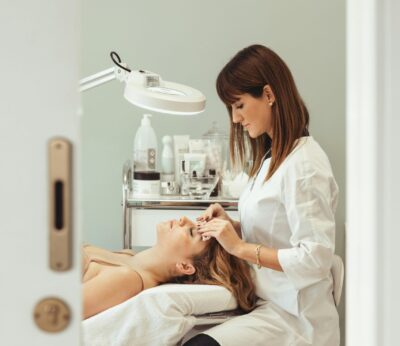Invisalign promises to straighten crowded or crooked teeth discreetly. But is it worth the hype? We find out.
Oral hygiene brand TePe’s recent ‘Behind Your Smile’ campaign revealed that 60% of adults dislike the way their grin looks in a photograph, mostly because of discoloured, crooked or missing teeth. If you’re on the quest for a straighter smile, the good news is that metal and wire braces are no longer your only option.
Dr Usha Ramjas, a dentist and co-founder of Dental Studio, is an advocator of Invisalign, a bespoke, clear aligner system at the forefront of dental therapy. “It uses cutting-edge technology to create a series of almost invisible and removable aligners,” she says. “Aligners are custom-made to the shape of the patient’s teeth from a specialised, patented SmartTrack material that’s laser trimmed and designed for better tooth movement, control and predictability.”
These clear aligners can help to straighten minor to complex misalignment, with the length of treatment taking an average of six months. “This is dependent on the complexity of the case,” says Dr Ramjas. “Most people feel a difference after wearing Invisalign for around three months.”
Whereas conventional ‘train track’ braces are fixed and visible, Invisalign is discreet and removable. “As well as being more comfortable and better tolerated by patients, Invisalign also supports the maintenance of oral hygiene, since aligners can be taken out, for example when eating and drinking,” says Dr Ramjas.
Read more: Skinimalism: How to create a super simple skincare routine

Are there any risks?
Dr Ramjas emphasises there are no real dangers involved in the procedure, but patients should only try Invisalign if they’re classified as suitable by their dentist. “Ideally, you need healthy gums and sufficient healthy bone,” she says. “As it’s a removable brace, its success is also largely dependent on the patient’s compliance and wearing the aligners as prescribed by your dentist.”
Many of Dental Studio’s patients who’ve tried the treatment seem to have regained their confidence. “Alongside whitening, Invisalign is the simplest, non-invasive smile makeover you can have,” says Dr Ramjas. “I also like to think of it as an anti-ageing treatment. As we age, it starts to show in our teeth. Realigning and putting the teeth in a better position creates a broader smile. This, in turn, provides more support for the lips and results in greater tooth display — both of which make us look younger.”
Not for everyone
Still, in cases when teeth are more seriously misaligned, a long-term brace could be more effective.
“Because of the fact that braces are attached directly to the teeth and worn permanently, they can work faster than Invisalign to close gaps and straighten teeth, and can be perfect for fixing overcrowding and/or misalignment,” says cosmetic dentist Dr Sam Jethwa. “For adults, we use white or tooth-coloured braces, rather than metal, so patients can get the benefits of quicker treatment along with more complex movements, and no chance of forgetting an aligner,” he adds.
“Braces are incredibly strong, with greater force to move teeth into the desired position, which is usually more effective when addressing more complex issues relating to jaw alignment and bite.”
Be it Invisalign or braces, your dentist should be able to identify the right solution for you, so you can smile freely and with confidence again.
The average cost for Invisalign treatment in London and the UK is around £1,500 to £5,500, while braces cost from around £2,500.
Read more: Five waterproof mascaras to buy this autumn

Invisalign Frequently Asked Questions
Is it painful?
Patients can experience mild discomfort in the first week, but this should subside quickly.
Will it damage my teeth?
No, it’s the simplest non-invasive teeth treatment you can have.
Do I have to wear retainers?
Yes. After completing treatment, you’ll need to wear retainers for 22 hours per day for the first three months. This is gradually decreased to eventually wearing retainers for four to five nights per week. Wearing them every night is recommended.
How often do I need to see the dentist?
Around every six to eight weeks, but this is dependent on the treating dentist.
How do I know what my teeth will look like after the treatment?
A scan of your mouth can show you a simulation of what your teeth could look like after treatment.













